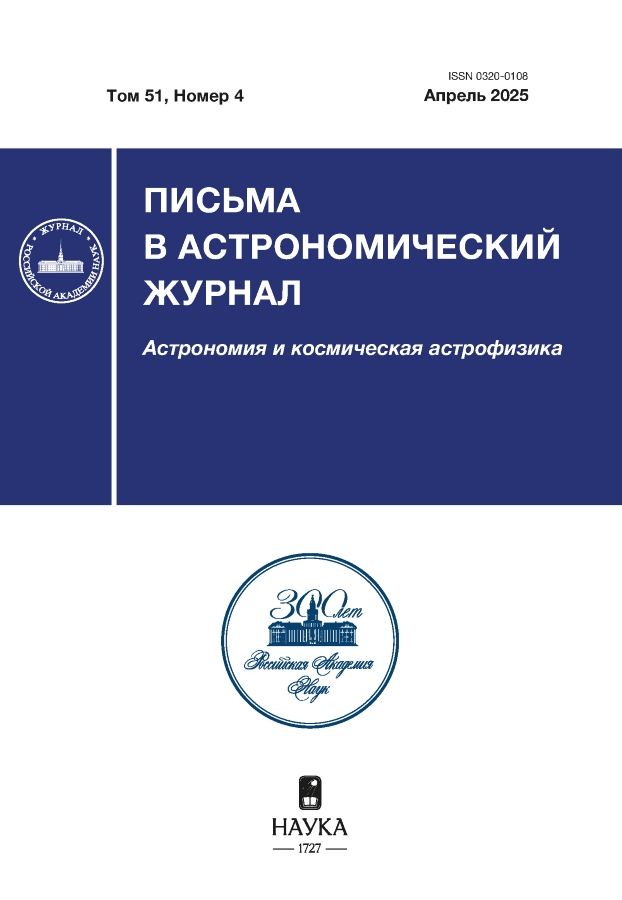Том 49, № 6 (2023)
Статьи
ТРАНЗИЕНТНЫЕ СОБЫТИЯ В ОКОЛОЯДЕРНЫХ ОБЛАСТЯХ АЯГ И КВАЗАРОВ КАК ИСТОЧНИКИ ИМИТАЦИЙ СОБСТВЕННЫХ ДВИЖЕНИЙ
Аннотация
Настоящая работа представляет собой расширение исследования Хамитова и др. (2022) в части каталога и астрофизической интерпретации имитации значимых собственных движений в галактиках с активными ядрами и квазарах по данным космической обсерватории Gaia. Представлена выборка рентгеновских источников СРГ/еРозита, расположенных в восточной галактической полусфере (\({0^{\circ}
 369-398
369-398


What Can We Learn about Compton-thin AGN Tori from Their X-Ray Spectra?1
Аннотация
We have developed a Monte Carlo code for simulation of X-ray spectra of active galactic nuclei (AGN) based on a model of a clumpy obscuring torus. Using this code, we investigate the diagnostic power of X-ray spectroscopy of obscured AGN with respect to the physical properties and orientation of the torus, namely: the average column density, \(\langle N_{\textrm{H}}\rangle\), the line-of-sight column density, \(N_{\textrm{H}}\), the abundance of iron, \(A_{\textrm{Fe}}\), the clumpiness (i.e. the average number of gas clouds along the line of sight), \(\langle N\rangle\), and the viewing angle, \(\alpha\). In this first paper of a series, we consider the Compton-thin case, where both \(\langle N_{\textrm{H}}\rangle\) and \(N_{\textrm{H}}\) do not exceed \(10^{24}\) cm\({}^{-2}\). To enable quantitative comparison of the simulated spectra, we introduce five measurable spectral characteristics: the low-energy hardness ratio (ratio of the continuum fluxes in the 7–11 keV and 2–7 keV energy bands), the high-energy hardness ratio (ratio of the continuum fluxes in the 10–100 keV and 2–10 keV energy bands), the depth of the iron K absorption edge, the equivalent width of the Fe K\(\alpha\) line, and the fraction of the Fe K\(\alpha\) flux contained in the Compton shoulder. We demonstrate that by means of X-ray spectroscopy it is possible to tightly constrain \(\langle N_{\textrm{H}}\rangle\), \(N_{\textrm{H}}\) and \(A_{\textrm{Fe}}\) in the Compton-thin regime, while there is degeneracy between clumpiness and viewing direction.
 399-400
399-400


ОПРЕДЕЛЕНИЕ СКОРОСТИ ВРАЩЕНИЯ СПИРАЛЬНОГО УЗОРА МЛЕЧНОГО ПУТИ ПО МОЛОДЫМ РАССЕЯННЫМ ЗВЕЗДНЫМ СКОПЛЕНИЯМ
Аннотация
Оценка скорости вращения спирального узора Галактики \(\Omega_{p}\) выполнена по большой выборке молодых рассеянных звездных скоплений (РЗС). Для этого было использовано 2494 РЗС моложе 50 млн лет. Средние значения их собственных движений, лучевых скоростей и расстояний были вычислены в работе Хант, Рефферт (2023) по данным каталога Gaia DR3. Для оценки \(\Omega_{p}\) применены три способа. Все они основаны на линейной теории спиральной волны плотности Лина и Шу. Первым способом, наиболее надежным с нашей точки зрения, с использованием скоростей возмущения \(f_{R}\) и \(f_{\theta}\), найденным в результате спектрального анализа радиальных \(V_{R}\) и остаточных скоростей вращения \(\Delta V_{\rm circ}\), получена оценка \(\Omega_{p}=24.26\pm 0.52\) км/с/кпк. Вторым способом скорости \(f_{R}\) и \(f_{\theta}\) были найдены из решения основных кинематических уравнений совместно с параметрами вращения Галактики, и получена оценка \(\Omega_{p}=23.45\pm 0.53\) км/с/кпк. Третьим способом, основанным на анализе позиционных углов РЗС на момент их рождения \(\theta_{\rm birth}\), найдено \(\Omega_{p}=28.9\pm 2.8\) км/с/кпк.
 401-411
401-411


ОПРЕДЕЛЕНИЕ ПАРАМЕТРОВ НЕЛИНЕЙНОЙ КИНЕМАТИЧЕСКОЙ МОДЕЛИ ВРАЩЕНИЯ ГАЛАКТИКИ НА БАЗЕ СОБСТВЕННЫХ ДВИЖЕНИЙ И ЛУЧЕВЫХ СКОРОСТЕЙ ЗВЕЗД КАТАЛОГА GAIA DR3
Аннотация
Решены звездно-кинематические уравнения Огородникова–Милна в галактической прямоугольной системе координат по полным скоростям для специальной выборки звезд, имеющих данные о лучевых скоростях, из финального каталога Gaia Data Release 3. Найдена область применения линейной модели и области, которые она уже плохо описывает. Построена модель второго порядка, более точно учитывающая особенности кинематики звезд, показана ее применимость для звезд, находящихся на расстоянии до 5 кпк.
 412-425
412-425


АЗИМУТАЛЬНЫЕ СТРУКТУРЫ В ПЛАНЕТЕЗИМАЛЬНЫХ ОКОЛОЗВЕЗДНЫХ ДИСКАХ
Аннотация
Рассмотрены пути формирования азимутальных резонансных структур в околозвездных планетезимальных дисках с планетами. Путем аналитических оценок и массовых численных экспериментов показано, что частицы диска, исходно попадающие в области резонансов средних движений низких порядков с планетой, со временем могут концентрироваться в потенциально наблюдаемые азимутальные структуры. Процесс структурирования протекает быстро, обычно он занимает время \({\sim}\)100 орбитальных периодов планеты. Найдено, что относительное количество частиц, сохраняющих свое резонансное положение, растет с уменьшением массового параметра \(\mu\) (отношения масс возмущающей планеты и родительской звезды), но всегда имеет место удаление существенной доли частиц из диска за счет их аккреции на звезду и планету, а также перехода на сильно вытянутые и гиперболические орбиты. Построены ожидаемые радиоизображения азимутально структурированных дисков. В рассмотренных нами моделях наиболее четко проявились азимутальные структуры, ассоциированные с резонансами \(2:1\) и \(3:2\); вероятны также наблюдательные проявления резонансов \(1:2\) и \(2:3\).
 426-438
426-438













